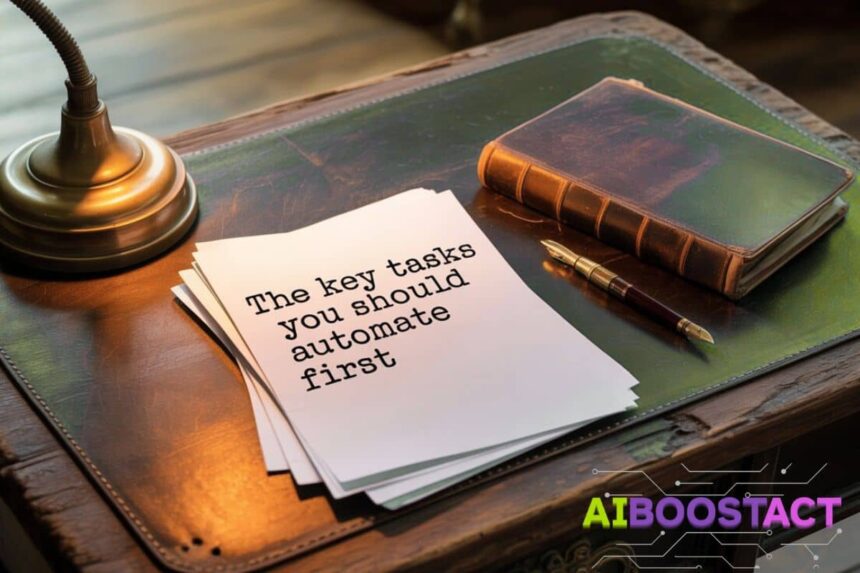Most solopreneurs wait too long to automate — telling themselves they need more time, more income, or more tools before they “systemize.”
But the truth is: automation is what unlocks growth, not what comes after it.
For the big-picture strategy of why AI is your leverage, see the
pillar guide on building and scaling with AI.
This article is your shortcut. Instead of wasting energy on repetitive tasks that don’t scale, you’ll learn what to automate first — and how AI helps you build a lean machine that runs even when you don’t.
No tech degree. No team. Just smart systems.
You don’t need to automate everything — just the right things.
As a solopreneur, your time is your scarcest resource. And the real leverage from AI comes not from using every tool under the sun, but from knowing
where to start. For context on choosing the right leverage, read the
section on AI as your ultimate growth partner
in the pillar guide.
Automation is a form of prioritization. Every task you automate is a task you never have to do again. The goal isn’t to work faster. It’s to remove yourself from the work that doesn’t need you — so you can focus on what does.
Why not all tasks are worth automating
Before jumping into tools and workflows, let’s be clear:
automation only creates value when it removes friction from your growth.
If you need a strategic lens for this, the
pillar’s “from chaos to clarity” workflow
shows how to map bottlenecks first, then automate.
| Task type | Priority for automation | Why it matters |
|---|---|---|
| Repetitive & predictable | Highest | You waste energy repeating the same steps. These are easy wins. |
| Time-consuming, low-value | High | You free up hours without losing quality. |
| Delegatable but error-prone | Medium | Automation reduces risk of mistakes — especially with AI-supported logic. |
| Human and strategic | Don’t automate | These build your brand, relationships, and vision. You must own them. |
Reminder: You’re not replacing yourself. You’re removing the work that doesn’t need you.
Let’s dive into the real examples of high-leverage tasks to automate.
1. Inbox filtering and email categorization
Type: Repetitive & low-value
Why automate: Your inbox shouldn’t be your task manager. Most solopreneurs waste 1–2 hours/day just sorting through irrelevant emails.
AI tools:
- Gmail filters + Zapier → auto-categorize incoming emails
- Superhuman + AI plugins → highlight important messages, auto-sort newsletters
Pro tip: Tag leads, invoices, and client requests into different folders automatically. You’ll instantly reduce decision fatigue.
2. Social media scheduling
Type: Repetitive & predictable
Why automate: Posting content manually every day breaks your focus and wastes creative energy.
AI tools:
- FeedHive, Metricool, or Taplio
- Use AI to generate captions, schedule posts, and analyze engagement
Set up a 7-day AI content loop
once, and let the machine run.
3. Lead magnet delivery + email tagging
Type: Low-value but essential
Why automate: Every time someone downloads your freebie, they expect a confirmation email. Doing this manually isn’t scalable.
Tools:
- MailerLite, Brevo (Sendinblue), or ConvertKit
- Auto-send PDFs, tag the subscriber, and trigger a welcome sequence
Learn how AI becomes your ultimate growth partner in this
foundational article.
4. Client onboarding & scheduling
Type: Delegatable but repetitive
Why automate: Booking calls and sending onboarding info eats up your bandwidth.
Tools:
- Calendly → auto-booking, timezone detection, reminders
- Notion AI or ChatGPT → personalized welcome emails, FAQ generators
5. File and content sorting
Type: Repetitive
Why automate: You create content daily — but where does it go? Manually organizing files leads to chaos.
Tools:
- Zapier + Google Drive or Notion → auto-tag and store new content
- Use AI to label content types: ideas, drafts, final, visuals, etc.
This supports your content machine. If you’re just getting started, start here:
AI-powered content machines.
Bonus: Use this decision table to prioritize your own tasks
| Task example | Effort to automate | ROI (Time saved weekly) | Automate? |
|---|---|---|---|
| Tagging new email subscribers | Low | High | ✅ |
| Designing custom email banners | High | Low | ❌ |
| Posting daily carousels on LinkedIn | Medium | High | ✅ |
| Approving affiliate applications | Medium | Medium | ⚠️ |
| Writing original thought-leadership | N/A | Priceless | ❌ |
Focus on tasks that meet these 3 criteria:
- Predictable
- Repetitive
- Not requiring emotional nuance
If it checks all 3, automate it today.
Build once, run forever: how to scale with automation
When you’re a solopreneur, every hour counts. And that’s why smart automation isn’t about doing everything — it’s about doing the right things once and letting them run forever.
This is where AI becomes more than just a helper — it becomes your infrastructure. For the mindset and operating system behind this, revisit the
pillar’s systems-first approach.
1. Lead capture and qualification
You shouldn’t have to chase every lead manually. With the right setup, you’ll wake up to new subscribers, segmented by interest, ready to nurture.
Automate this:
- AI-powered forms (Typeform + ChatGPT API): personalize questions and auto-qualify based on responses.
- Email list tagging (via Brevo, ConvertKit, or ActiveCampaign): auto-assign lead categories based on form answers or click behavior.
- AI chatbots (like ManyChat or Intercom with GPT integration): answer basic questions and move leads through your funnel — 24/7.
“Instead of scheduling 10 calls with unqualified leads, automation let me focus on the 2 who were actually ready to buy.”
— Lena Rey, Solo Funnel Architect
Repeatability effect: Every qualified lead gets the same high-quality onboarding — with zero effort on your part after setup.
2. Sales and conversion workflows
Most solopreneurs fear selling. But what if sales happened without you — even while you sleep?
AI tools can help you build self-optimizing funnels that adapt based on behavior.
Automate this:
- Email sequences: Tools like Instantly.ai or MailerLite + GPT-generated copy can send 5–7 step nurture sequences based on lead type.
- Dynamic offers: Set up “if-behavior-then-offer” triggers — e.g., if a visitor clicks on a product but doesn’t buy, trigger a limited-time discount.
- Chat follow-ups: If someone messages your bot but doesn’t purchase, re-engage them via email or Messenger with contextual nudges.
| Funnel Stage | AI Automation Idea | Tools |
|---|---|---|
| Awareness | Auto-personalized welcome emails | MailerLite, Brevo |
| Consideration | Chatbot sequences + “Ask Me Anything” bots | ManyChat, Intercom |
| Decision | AI-based urgency triggers (e.g. cart reminders) | Crisp, Deadline Funnel |
Your AI sales assistant never forgets, never hesitates, and never sleeps.
3. Content repurposing and omnichannel scheduling
You’ve already written a killer LinkedIn post — but that shouldn’t be the end of its life.
AI lets you turn 1 idea into 7 assets, auto-scheduled across platforms.
Automate this:
- Repurposing engines: Tools like Taplio, Repurpose.io, or Jasper can transform a blog post into:
- A tweet thread
- A carousel
- A short-form video script
- A newsletter snippet
- Auto-schedulers: Tools like Metricool or Buffer let you preload content for the week/month — no daily hustle.
“Content stopped being a task. It became a rhythm. My AI tools now remix, schedule, and adapt my voice across platforms — while I build my next product.”
— Abdeslame Eddabbarh, AiBoostAct
This isn’t just productivity. This is presence at scale.
From hustle to harmony: your automation roadmap
Let’s wrap this up with a clear roadmap. If you’re overwhelmed, don’t try to automate everything at once. Start with high-leverage systems — then stack the rest.
Step-by-step automation starter plan:
| Phase | Focus Area | Tools to Use |
|---|---|---|
| Phase 1 | Lead capture + email follow-up | Brevo, Typeform, Notion AI |
| Phase 2 | Sales workflows (emails, bots) | Instantly.ai, Intercom, GPT-4o |
| Phase 3 | Content repurposing + scheduling | Taplio, Repurpose.io, Buffer, Canva |
- Start where your time leaks the most.
- Pick tools that talk to each other (Zapier, Make, or native integrations).
- Automate for output, not complexity.
You don’t need to automate everything. You need to automate the right things — first.
If you’ve implemented even one of these AI-powered systems, you’ve already started building the infrastructure of a scalable business. These aren’t just hacks — they’re habits that free your focus, increase your visibility, and move leads from interest to action without burning you out.
The shift isn’t just tactical. It’s mental: from doing all the work yourself, to designing systems that work for you.
Now, it’s your turn:
What’s the one task you know you should automate — but haven’t yet?
Drop it in the comments — we might just build the AI workflow for you.
Read the full pillar guide: build & scale with AI — without a team or burnout →






